-
Membership
Membership
Anyone with an interest in the history of the built environment is welcome to join the Society of Architectural Historians -
Conferences
Conferences
SAH Annual International Conferences bring members together for scholarly exchange and networking -
Publications
Publications
Through print and digital publications, SAH documents the history of the built environment and disseminates scholarship -
Programs
Programs
SAH promotes meaningful engagement with the history of the built environment through its programsMember Programs
-
Jobs & Opportunities
Jobs & Opportunities
SAH provides resources, fellowships, and grants to help further your career and professional life -
Support
Support
We invite you to support the educational mission of SAH by making a gift, becoming a member, or volunteering -
About
About
SAH promotes the study, interpretation, and conservation of the built environment worldwide for the benefit of all
Louis I. Kahn Study Tour: Institutional Work
by: Amber Wiley
Institutional, Community, and Religious Work
.jpg?sfvrsn=76558165_2)
During the tour we traveled to New Haven to view some of Kahn’s most famous institutional work. Carter Wiseman led us on tours of the Yale University Art Gallery and the Yale Center for British Art, with a quick trip to the archives of Sterling Memorial Library to view original drawings by Kahn and Paul Rudolph.
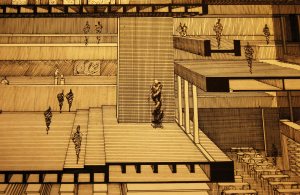
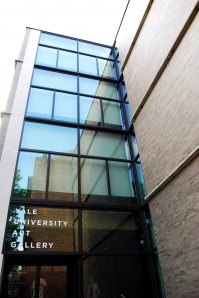
The Yale University Art Gallery (with Douglass Orr, 1951-53) is considered by many to be Kahn’s earliest substantial commission. The Yale University Art Gallery (YUAG) was the first of three art museums that Kahn would design, and was dramatically different from the context of buildings on the Yale campus, many of which were designed by James Gamble Rogers in a neo-Gothic vocabulary. The main façade of the YUAG is highly simplistic, with string coursework that runs the length of the building, slightly mimicking the levels of articulation in the adjacent original 1928 “Tuscan Romanesque” building by architect Edgerton Swartwout.
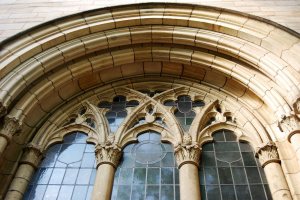
One of Kahn’s major innovations in the YUAG was the use of the tetrahedron ceiling design that housed the electric and ventilation systems. The YUAG originally included art and architecture studios as part of its building program.
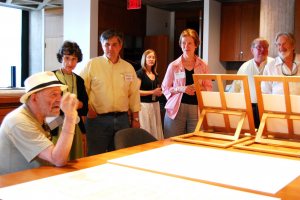
The building underwent extensive renovation by Polshek Partnership, LLP, which was completed in 2006 and brought the building closer to Kahn’s original vision.
-sculpture-in-a-courtyard-re-opened-for-the-renovation.jpg?sfvrsn=f832dbf7_2)
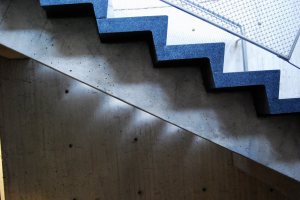
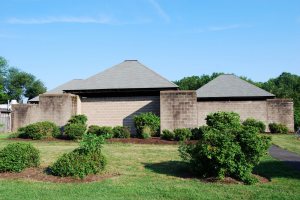
We also visited the Jewish Community Center Bath House and Day Camp (1954-59) outside Trenton, New Jersey. A guided tour of the site revealed extensive neglect as evidenced by the water damage, deterioration, and patina on the exposed concrete surfaces of the building. Immediate plans for restoration of the building were outlined on the tour. This icon of modernism was simple and elegant, with a cruciform plan, a central atrium, and four square concrete block rooms. Each room was topped with a pyramidal roof. This building displayed ingenuity in its simplicity, and was the point where Kahn crystallized his ideas about “served spaces” and “spaces that serve.”
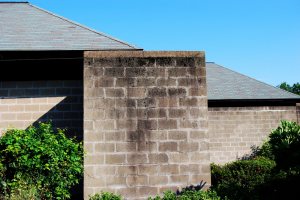
I discovered myself after designing that little concrete block bathhouse in Trenton.
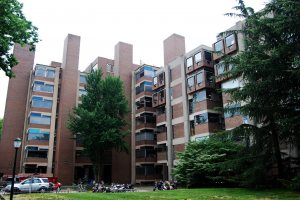
It was the Richards Medical Building (1957-61) on the campus of the University of Pennsylvania that was a true breakthrough for Kahn in the form of critical acclaim in and outside of the architectural sphere. Some of the major themes that characterized Kahn’s work were evident in our guided tour: heavy external massing that clearly demarcated “served” and “servant” spaces, rigid geometrical structural systems, refinement of exposed materials, and the dissolution of the corner. Kahn’s use of concrete cantilever technology in the medical labs allowed for the creation of a space that did not depend on structural support at the corner, hence the ability to leave large expanses of glass meeting at a point on the far end of the lab.
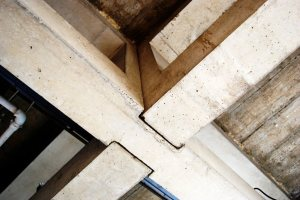
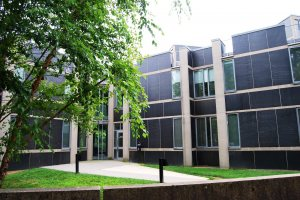
Erdman Hall (1960-65) at Bryn Mawr College is a dormitory on the women’s liberal arts campus. Here Kahn created the major spaces by designing a plan of intersecting diamonds, putting the service areas in the middle, and stringing the student rooms around the periphery of the building. Kahn used slate on the exterior, a choice that made the building fit with the rest of the campus’ color palette, while setting a direct precedent in contrast to the medieval Gothic aesthetic that pervaded the campus.
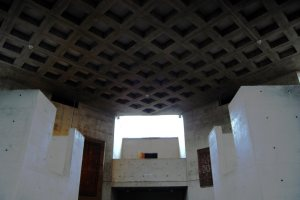
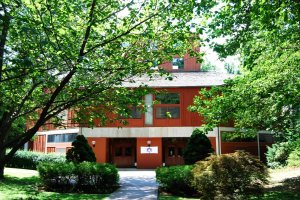
The Temple Beth-El Synagogue (1966-72) in Chappaqua, New York is clad almost completely in wood with concrete framing, a testament to its design inspiration- the wooden synagogues in Europe that were destroyed during the Holocaust. Kahn abstracted the shape of the typical wooden synagogue to geometric simplicity, literally resting the elevated square roof and walls of the sanctuary on massive concrete pillars, creating a dialogue of light, weight, and gravity between the upper and lower parts of the sanctuary.
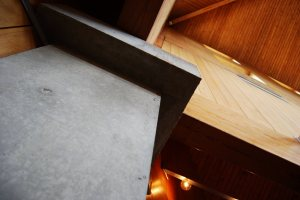
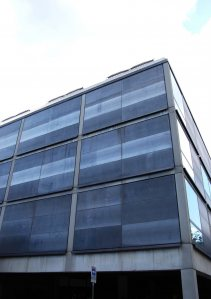
The Yale Center for British Art (Kahn, 1969-74; Pellechia & Meyers 1974-1977) was completed after Kahn’s untimely death. It is very much a jewel of a building that not only speaks to its surroundings with street level shops that invite pedestrians in, but also creates the soft ambiance of an old English country house on the interior. Kahn delivered his signature flood of natural light in the form of two major interior courtyards, one at the entrance and one that is located deep within the museum and is flanked by archival and research centers.
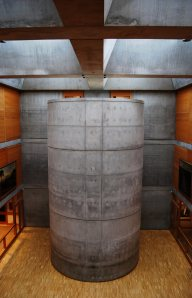
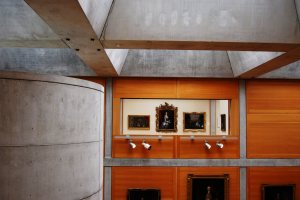
Contrasted with the Yale University Art Gallery, the Yale Center for British Art had a softer palette of materials. The YUAG was constructed of brick, concrete, glass, and steel, while the Yale Center for British Art utilized marble, white oak, and Belgian linen.
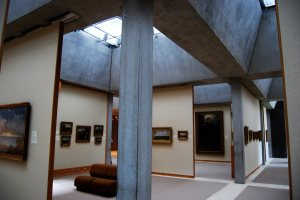
Institutional, Community, and Religious Work
.jpg?sfvrsn=76558165_2)
During the tour we traveled to New Haven to view some of Kahn’s most famous institutional work. Carter Wiseman led us on tours of the Yale University Art Gallery and the Yale Center for British Art, with a quick trip to the archives of Sterling Memorial Library to view original drawings by Kahn and Paul Rudolph.


The Yale University Art Gallery (with Douglass Orr, 1951-53) is considered by many to be Kahn’s earliest substantial commission. The Yale University Art Gallery (YUAG) was the first of three art museums that Kahn would design, and was dramatically different from the context of buildings on the Yale campus, many of which were designed by James Gamble Rogers in a neo-Gothic vocabulary. The main façade of the YUAG is highly simplistic, with string coursework that runs the length of the building, slightly mimicking the levels of articulation in the adjacent original 1928 “Tuscan Romanesque” building by architect Edgerton Swartwout.

One of Kahn’s major innovations in the YUAG was the use of the tetrahedron ceiling design that housed the electric and ventilation systems. The YUAG originally included art and architecture studios as part of its building program.

The building underwent extensive renovation by Polshek Partnership, LLP, which was completed in 2006 and brought the building closer to Kahn’s original vision.
-sculpture-in-a-courtyard-re-opened-for-the-renovation.jpg?sfvrsn=f832dbf7_2)


We also visited the Jewish Community Center Bath House and Day Camp (1954-59) outside Trenton, New Jersey. A guided tour of the site revealed extensive neglect as evidenced by the water damage, deterioration, and patina on the exposed concrete surfaces of the building. Immediate plans for restoration of the building were outlined on the tour. This icon of modernism was simple and elegant, with a cruciform plan, a central atrium, and four square concrete block rooms. Each room was topped with a pyramidal roof. This building displayed ingenuity in its simplicity, and was the point where Kahn crystallized his ideas about “served spaces” and “spaces that serve.”

I discovered myself after designing that little concrete block bathhouse in Trenton.

It was the Richards Medical Building (1957-61) on the campus of the University of Pennsylvania that was a true breakthrough for Kahn in the form of critical acclaim in and outside of the architectural sphere. Some of the major themes that characterized Kahn’s work were evident in our guided tour: heavy external massing that clearly demarcated “served” and “servant” spaces, rigid geometrical structural systems, refinement of exposed materials, and the dissolution of the corner. Kahn’s use of concrete cantilever technology in the medical labs allowed for the creation of a space that did not depend on structural support at the corner, hence the ability to leave large expanses of glass meeting at a point on the far end of the lab.


Erdman Hall (1960-65) at Bryn Mawr College is a dormitory on the women’s liberal arts campus. Here Kahn created the major spaces by designing a plan of intersecting diamonds, putting the service areas in the middle, and stringing the student rooms around the periphery of the building. Kahn used slate on the exterior, a choice that made the building fit with the rest of the campus’ color palette, while setting a direct precedent in contrast to the medieval Gothic aesthetic that pervaded the campus.


The Temple Beth-El Synagogue (1966-72) in Chappaqua, New York is clad almost completely in wood with concrete framing, a testament to its design inspiration- the wooden synagogues in Europe that were destroyed during the Holocaust. Kahn abstracted the shape of the typical wooden synagogue to geometric simplicity, literally resting the elevated square roof and walls of the sanctuary on massive concrete pillars, creating a dialogue of light, weight, and gravity between the upper and lower parts of the sanctuary.


The Yale Center for British Art (Kahn, 1969-74; Pellechia & Meyers 1974-1977) was completed after Kahn’s untimely death. It is very much a jewel of a building that not only speaks to its surroundings with street level shops that invite pedestrians in, but also creates the soft ambiance of an old English country house on the interior. Kahn delivered his signature flood of natural light in the form of two major interior courtyards, one at the entrance and one that is located deep within the museum and is flanked by archival and research centers.


Contrasted with the Yale University Art Gallery, the Yale Center for British Art had a softer palette of materials. The YUAG was constructed of brick, concrete, glass, and steel, while the Yale Center for British Art utilized marble, white oak, and Belgian linen.




Leave a commentOrder by
Newest on top Oldest on top